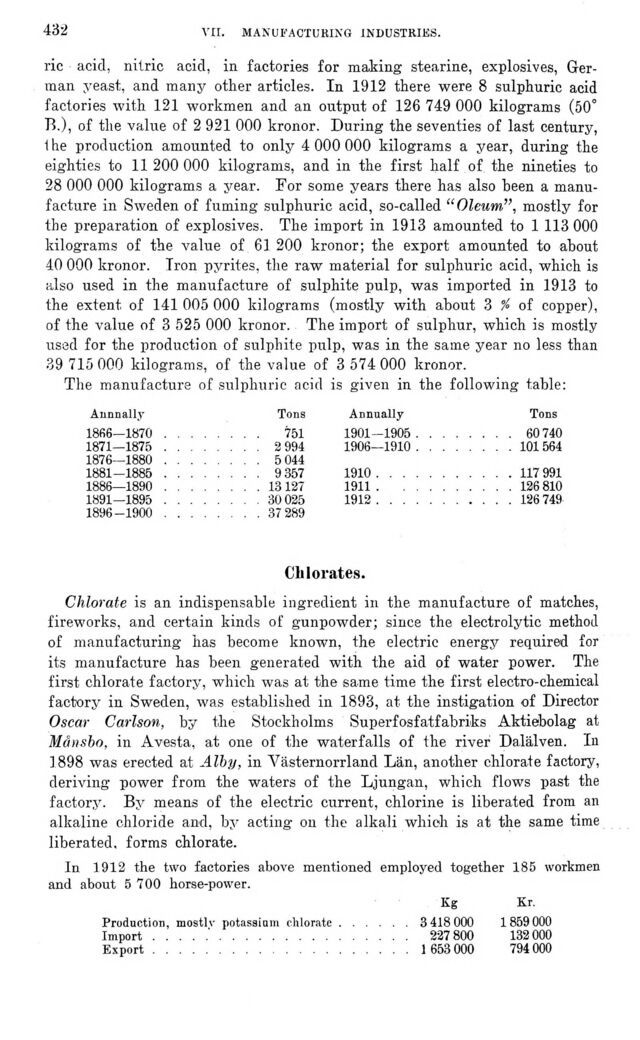
Full resolution (JPEG) - On this page / på denna sida - VII. Manufacturing Industries. Introd. by [G. Sundbärg] K. Åmark - 9. Chemical Industries. By Alf. Larson

<< prev. page << föreg. sida << >> nästa sida >> next page >>
Below is the raw OCR text
from the above scanned image.
Do you see an error? Proofread the page now!
Här nedan syns maskintolkade texten från faksimilbilden ovan.
Ser du något fel? Korrekturläs sidan nu!
This page has never been proofread. / Denna sida har aldrig korrekturlästs.
432
vii. manufacturing industries.
ric acid, nitric acid, in factories for making stearine, explosives,
German yeast, and many other articles. In 1912 there were 8 sulphuric acid
factories with 121 workmen and an output of 126 749 000 kilograms (50°
15.), of the value of 2 921 000 kronor. During the seventies of last century,
1 he production amounted to only 4 000 000 kilograms a year, during the
eighties to 11 200 000 kilograms, and in the first half of the nineties to
28 000 000 kilograms a year. For some years there has also been a
manufacture in Sweden of fuming sulphuric acid, so-called "Oleum", mostly for
the preparation of explosives. The import in 1913 amounted to 1 113 000
kilograms of the value of 61 200 kronor; the export amounted to about
40 000 kronor. Iron pyrites, the raw material for sulphuric acid, which is
also used in the manufacture of sulphite pulp, was imported in 1913 to
the extent of 141 005 000 kilograms (mostly with about 3 % of copper),
of the value of 3 525 000 kronor. The import of sulphur, which is mostly
used for the production of sulphite pulp, was in the same year no less than
39 715 000 kilograms, of the value of 3 574 000 kronor.
The manufacture of sulphuric acid is given in the following table:
Annnally Tons
1866—1870 . . . . .... 751
1871—1875 . . . . . . . . 2 994
1876—1880 . . . . .... 5044
1881-1885 . . . . .... 9357
1886—1890 .... . . . .13127
1891-1895 . . . . .... 30025
1896-1900 . . . . .... 37289
1901—1905 ........ 60 740
1906—1910 ........ 101 564
1910 ........... 117 991
1911 .......... 126 810
1912 ........... 126 749
Chlorates.
Chlorate is an indispensable ingredient in the. manufacture of matches,
fireworks, and certain kinds of gunpowder; since the electrolytic method
of manufacturing has become known, the electric energy required for
its manufacture has been generated with the aid of water power. The
first chlorate factory, which was at the same time the first electro-chemical
factory in Sweden, was established in 1893, at the instigation of Director
Oscar Carlson, by the Stockholms Superfosfatfabriks Aktiebolag at
Månsbo, in Avesta, at one of the waterfalls of the river Dalälven. In
1898 was erected at Alby, in Västernorrland Län, another chlorate factory,
deriving power from the waters of the Ljungan, which flows past the
factory. By means of the electric current, chlorine is liberated from an
alkaline chloride and, by acting on the alkali which is at the same time
liberated, forms chlorate.
In 1912 the two factories above mentioned employed together 185 workmen
and about 5 700 horse-power.
Kg Kr.
Production, mostlv potassium chlorate...... 3 418 000 1859 000
Import.................... 227 800 132 000
Export.................... 1 653 000 794 000
<< prev. page << föreg. sida << >> nästa sida >> next page >>